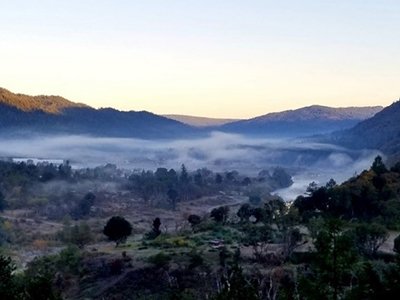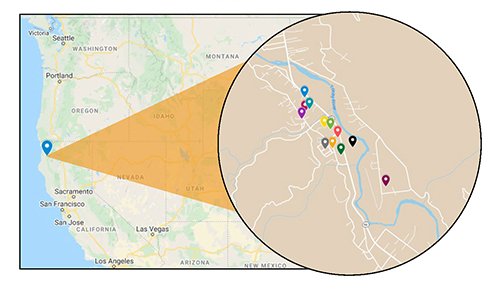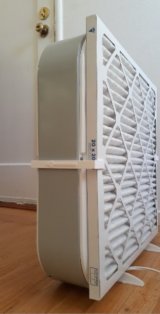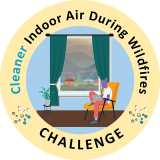Wildfire Study to Advance Science Partnerships for Indoor Reductions of Smoke Exposures

On this page:
- Study Objectives
- Monitoring Approach
- Study Location: Missoula, MT
- Study Location: Hoopa, CA
- Laboratory Study on Air Cleaning Technology
- Safety Testing of DIY Air Cleaners
- ASPIRE-Health Study
- Prize-based Challenge
- Commercial and School Building Guidance Collaboration
- Community Partners
- Additional Links and Resources
Wildfire smoke can infiltrate indoors, emphasizing the importance of creating cleaner air spaces that effectively reduce smoke exposures. To fill knowledge gaps about public buildings or facilities where people congregate during smoke episodes, EPA researchers are working with community and tribal partners in Montana and California to study how air cleaning and ventilation practices impact indoor air quality during wildfires. In addition, EPA researchers and their partners are interested in more information about technologies people can use to provide cleaner air spaces in their homes.
Many communities may be exposed to smoke from wildland fires, including wildfires and prescribed or controlled burns, for days, weeks, or even months each year. This smoke exposure can lead to increased health risks. To reduce exposure, a common recommendation is to stay indoors away from the smoke and close all doors and windows.
Information on current particulate matter air quality, fire locations and smoke plumes, smoke forecast outlooks, and recommendations for actions to take before, during, and after a wildfire are available on AirNow's Wildfire webpage.
Additional resources are available on EPA's Smoke-Ready Toolbox for Wildfires.
Study Objectives
EPA researchers are partnering in a study with the Missoula City-County Health Department (MCCHD) in Montana, University of Montana, the Hoopa Valley Tribe in California, and other communities to measure air pollutants under typical conditions and when smoke episodes are anticipated. The objectives of the research—called the Wildfire Advancing Science Partnerships for Indoor Reductions of Smoke Exposures (ASPIRE) Study—are to compare indoor and outdoor fine particulate matter (PM2.5) concentrations and develop strategies for reducing indoor pollutants in public buildings during wildland fire smoke events. PM2.5 is the pollutant that is a primary health threat from smoke exposures.
Additional components of the project include laboratory evaluations of air cleaning technology performance under wildfire smoke conditions, a prize-based challenge to encourage innovative ideas for air cleaning approaches in homes, and a study to assess the use of air cleaners in homes to improve indoor air quality and health outcomes during smoke events. The research activities are described below.
The project is part of an initiative that emphasizes working directly with stakeholders to develop solutions to public health and environmental concerns. The research has involved local partners from the beginning to identify what information they need to effectively communicate actions that building owners and the public can take to reduce public health risks during smoke episodes.
The research findings can be used by air quality managers, public health professionals and others to reduce community health risks from smoke exposure and expand understanding of the impact of building characteristics and ventilation systems on indoor air quality during smoke episodes. This project is designed to serve as a model for future community-based research on how to engage partners throughout a research project.
The research questions for this study are:
- How effective are air filtration systems during smoke events?
- What are the concentrations of PM2.5 indoors and outdoors?
- How does filtration effectiveness vary by outdoor concentration and type of air handling system?
- How effective are portable air cleaners in reducing PM2.5 concentrations?
- What operation and maintenance factors are important in air cleaner effectiveness?
- What innovative approaches can help reduce wildfire smoke exposures?
Monitoring Approach

In 2019, researchers began conducting field monitoring of PM2.5 concentrations inside and outside of commercial and public buildings in Missoula and Hoopa to understand real-world variation under typical ambient conditions and when smoke events occur. Researchers selected an air sensor that relies on an optical detection method and collects a data point every two minutes. They co-located the sensors with regulatory grade reference monitors to evaluate their accuracy and developed a correction equation to reduce any bias in the sensor data.
In addition to stationary monitoring, researchers are using a portable, mobile monitoring system they developed to map outdoor smoke concentrations and observe how concentrations vary when smoke funnels into mountain valleys and surrounding areas. The monitoring system, Vehicle Add-on Mobile Monitoring System (VAMMS), is the size of a small brief case and can be mounted to a vehicle to take mobile measurements in a designated area.
EPA has built additional VAMMS to lend to federal, state, tribal and local air organizations as part of the Wildfire Smoke Air Monitoring Response Technologies (WSMART) Pilot. The monitoring equipment will be used in areas experiencing wildfires to provide more air quality monitoring capabilities.
Learn more about the WSMART pilot.
Find the form to request air monitoring equipment on loan.
The research team will share findings from the field studies in Missoula and Hoopa with the local and tribal partners and publish in the peer-reviewed literature.
Study Location: Missoula, Montana

Missoula was selected as a study location due to an extreme smoke season in 2017 and the local health department’s enthusiasm and dedication to improve understanding of clean air spaces within their community. EPA partnered with the Missoula City-County Health Department (MCCHD), University of Montana, U.S. Forest Service Fire Sciences Laboratory, and Climate Smart Missoula to design and implement the field study.
Missoula partners and EPA researchers focused on public and commercial buildings used by larger numbers of people during fire season such as fitness centers, museums, senior centers, and office spaces. MCCHD worked with property owners to obtain site permission, plan specific locations inside and outside for placing air measurement equipment, and identify points of contact who would be available throughout the summer to coordinate and collect monitoring data.
The Missoula field study included measuring air quality during two wildfire seasons. The first wildfire season in 2019 involved collecting measurements at 18 buildings from late July to early September. During this period, there were two prescribed fire events in August.
A second season of field testing began in June 2020 and included measurements at 17 buildings. Adjustments were made to the field study approach, building on lessons learned from the previous year’s testing, which included converting the sensors to automatic data reporting, expanding sampling to two nearby towns to potentially capture more smoke events, extending the timeframe of measurements into the fall to potentially capture more smoke events, and increasing the diversity of buildings monitored. Air ventilation systems in a variety of the study locations were evaluated to better understand how building characteristics or occupant practices affect indoor air pollutant concentrations. During the 2020 study period, a week of sustained high PM2.5 concentrations related to wildfire smoke was observed in mid-September.
Monitoring in Missoula has been completed. EPA researchers are currently analyzing the data collected.
Study Location: Hoopa Valley Tribe, California

Hoopa was selected as a study location due to the risk of wildfire smoke impacts extending from summer into the late fall, and wood smoke impacts and frequent atmospheric inversions during winter, which traps air pollution close to the ground. If the air is stagnant for too long, air pollution will accumulate. EPA researchers chose to partner with the Hoopa Valley Tribe and the Tribal Environmental Protection Agency (TEPA) after the Tribe expressed an interest in participating in the project to learn more about indoor air quality and creating cleaner air spaces in their community.
At the Hoopa Valley Tribal Reservation, air sampling was conducted on a continual basis between December 2019 and March 2022 at 13 buildings to capture wildfire smoke episodes and other causes of heightened PM2.5 concentrations such as emissions from woodstoves and outdoor burning as well as atmospheric inversions. The field study includes fewer sampling sites than Missoula given the overall smaller geographic area and population size in Hoopa Valley. Researchers observed extremely high PM2.5 concentrations in Hoopa in October 2020 related to the Red Salmon Complex Fire.
Air quality monitoring in Hoopa has concluded and EPA researchers are currently analyzing the data collected.
Laboratory Study on Air Cleaning Technology

with an air filter clamped onto a box fan.
A complementary study is being carried out in the laboratory in Research Triangle Park, North Carolina, to learn more about how effective air cleaning technology is for reducing smoke indoors under simulated real-world conditions. Researchers are evaluating portable air cleaners, ranging from a Do-It-Yourself (DIY) air cleaner composed of a box fan with an attached furnace filter to commercial air cleaners. EPA partnered with Chemical Insights Research Institute of Underwriters Laboratories Inc. (UL) to conduct safety evaluations prior to testing the air cleaners under simulated smoke conditions. Learn more about the UL safety testing below.
The air cleaners are being evaluated for their effectiveness at removing PM2.5 and other toxic pollutants, as well as their ease of use and cost to operate. These experiments will help researchers understand the range of effectiveness that may be achieved using these air cleaner technologies to reduce smoke exposure and best practices for their use.
Safety Testing DIY Air Cleaners
EPA researchers supported safety testing by the Chemical Insights Research Institute of Underwriters Laboratories Inc. (UL) to assess the fire and burn risks from DIY air cleaners. These air cleaners are commonly used to filter smoke particles during wildfires and are made by attaching an air filter to a box fan with tape or a bungee cord. Since commercial air cleaners can be difficult to obtain during wildfires due to supply or cost, many health and air quality agencies and nonprofits have begun providing instructions for making these DIY air cleaners. UL has released a report on the testing results, Wildfire Safety Research: An Evaluation of DIY Air Filtration.
- Report: Wildfire Safety Research: An Evaluation of DIY Air Filtration
- Research on DIY Air Cleaners to Reduce Wildfire Smoke Indoors
ASPIRE-Health Study
EPA researchers partnered with the Hoopa Valley Tribe to add a study component in 2021 called ASPIRE-Health. Researchers tested the effectiveness of DIY and commercial air cleaners in improving air quality and health during the wildfire season and during wintertime in residences using woodstoves for heat.
Measurements for both the fall and winter ASPIRE-Health: Hoopa pilot studies are complete, and EPA researchers are currently analyzing the data. The lessons learned from these pilot studies are informing plans for a similar field study in a larger number of homes in central California. EPA researchers will partner with the Central California Environmental Justice Network (CCEJN) to evaluate the use of DIY and commercial air cleaners in homes in Tulare County during the 2023 wildfire season.
Prize-based Challenge

In October 2021, EPA announced the winners for Phase 1 of the Cleaner Indoor Air During Wildfires Challenge Competition. This challenge is sponsored by EPA in partnership with 10 federal, state, local, and tribal organizations. The goal of this challenge is to encourage development of new, effective, low-cost approaches (termed “solutions”) to remove PM2.5 from indoor air, particularly high concentrations related to smoke events or other high pollution episodes. Phase 2 of the Challenge, launched in 2022, invites Phase 1 winners to submit prototypes for evaluation.
Commercial and School Building Guidance Collaboration

EPA researchers and other federal and international organizations are serving on a committee organized by ASHRAE (formerly the American Society of Heating, Refrigerating and Air Conditioning Engineers) to develop guidelines for commercial buildings, including schools, to reduce smoke exposure for occupants. ASHRAE has released an interim planning framework that highlights steps to develop a building-specific smoke readiness plan by evaluating and preparing heating, ventilation, and air conditioning (HVAC) systems to filter smoke and other building measures to minimize smoke intrusion during wildfires and prescribed burning. The interim guidance document is entitled Planning Framework for Protecting Commercial Building Occupants from Smoke During Wildfire Events. The committee is developing a final guideline, which is expected to be completed in 2022.
- Planning Framework for Protecting Commercial Building Occupants from Smoke During Wildfire Events
- Wildfires and Indoor Air Quality in Schools and Commercial Buildings
- Flyer: Recommendations for Reducing Wildfire Smoke in Commercial Buildings and Schools
Community Partners
Additional Links and Resources
Related Resources
Presentations
-
Preparing for Wildland Fire Smoke – EPA Tools & Resources webinar, May 18, 2022
-
How to Evaluate Air Sensors for Smoke Monitoring - EPA Tools & Resources webinar, February 16, 2022
-
Using a Particle Sensor Network to Characterize Air Quality of Buildings in Areas Prone to Wildfires – Air Sensors International Conference (ASIC), October 22, 2020
-
Using a Particle Sensor Network to Characterize Indoor and Outdoor Air Quality of Buildings in Areas Prone to Wildfires - Third International Smoke Symposium (ISS3) Presentation – April 20-24, 2020
-
PM2.5 Measurements Inside and Outside of Buildings in Missoula, MT During Summer 2019 - Presentation of field study summary
-
Clean Air Spaces - Indoor Air Filtration to Protect Public Health During Wildland Fire Smoke Episodes - June 2019 web summit
